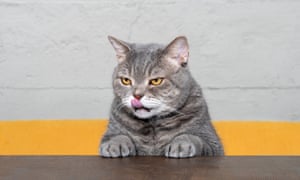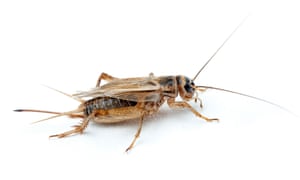Animal microbiologist Holly Ganz cannot talk about the pet feeding regime known as biologically appropriate raw food without laughing. The increasingly popular diet is known by its unfortunate acronym, Barf. “It’s bizarrely named,” she says, laughing. It certainly runs contrary to the twee language usually reserved for the pet realm; such as Kitty Biome, a project Ganz recently raised $23,000 (£17,000) for via Kickstarter, which invited cat owners to pay $100 to have the microorganisms in their cat’s droppings analysed. The common term for the environmental impact of pet-keeping has a cute name too: pawprint. But, with humans increasingly demanding human-grade meat for their four-legged family members, pet food is estimated to be responsible for a quarter of the environmental impacts of meat production in terms of the use of land, water, fossil fuels, phosphates and pesticides. And this trend for raw food is, environmentally speaking, a step backwards.
It is this carbon pawprint that Ganz is working to reduce. She has been drafted in to assess the gut-friendliness of a vegan pet-food product launching in the US in July called Wild Earth. Its first offering is a dog treat made from what the blurb calls an “ancient Asian” fungi called koji. “We’re hoping,” she says, “that it will support bacteria that will help to fight inflammation and maintain healthy digestion and nutrition.”
Ask Wild Earth’s CEO, Ryan Bethencourt, what the future of pet food looks like and he has one word: “Massive.” In 2017, the global pet-food market was worth $94bn, and it is projected to grow even further as new markets open up. In China, where pet ownership is rare, the market grew by 100% last year. “If China follows the trends, we are going to see hundreds of millions more pets in existence,” says Bethencourt. He thinks these pets can be fed sustainably with his koji protein while, for the longer term, the company is working on lab-grown meat, culturing meat cells that would not require rearing or killing animals. They have already created a mouse-meat prototype for cats that, it says, will beat lab meat for humans to market because there is less red tape to navigate. But it will be some time before the technology can be scaled up accordingly.

In the meantime, can eco-conscious cats and dogs survive on a vegan diet? “Cats are obligate carnivores,” says Ganz, which means a lot of what they need comes from meat, “whereas dogs are more scavengers and have amylase genes so they can digest starch.” But even a scientifically designed vegan or vegetarian diet for dogs, says Ganz, can be difficult to devise. Gudrun Ravetz, the president of the British Veterinary Association, agrees: “Theoretically, you can feed a dog a vegetarian diet, but it’s not something you do lightly and you definitely need to do it with a nutritionist. A lot of what cats need is found in animal protein. It may well be in this fungi, but I’d want to see evidence that these are in the fungi and they’re available to the animal.”
Bethencourt describes koji as a “whole food” with a great “amino acid” profile and 10% more protein than you would expect to find in a decent steak. “We have to add a few supplements, just as any meat-based protein company does, to make sure it has the right vitamins and minerals. The food has to be enough, nutritionally, for the animal to survive, and we found our protein is easily digested by dogs.” Bethencourt, who is soon to release a nutrient profile and digestibility study, was the first guinea pig for his dog food. And while pet food is usually tested by animals in labs, Wild Earth employs a humane process where the dogs used live at home and are volunteered by their owners.
He is confident that a nutritional cat food will follow. “Cats really need [the amino acids] carnitine and taurine in their food,” says Ravetz. “They are important for vision, the heart and the immune system, among other things. A lack of them can cause all kinds of problems.
“We think we can get the right nutrition relatively easily by supplementing koji, but cats are picky, so what we need to do is make sure they really love their food.”
There is already a more sustainable source of animal protein out there: insects. While the food industry struggles to make them more appetising to western humans, dogs have no trouble lapping them up. When Haley Russell began experimenting with her own small-scale cricket farm, her discerning goldendoodle, Wren, devoured the insects whenever she got the chance. Russell and the co-founders of Chipper Pets went on to talk to veterinarians, who, she says, “confirmed that insects are great for dogs. In fact, you get a different mix of amino acids that are really helpful for food variety, which is important for people and great for dogs, too.” Like Wild Earth, Chipper Pets is starting with a dog treat in peanut, pumpkin and cricket flavour, with the tagline: “Save water. Save land. Chip in.”
Crickets could serve as a main meal, too, high in iron and omega-3 oils and vitamin B12. “It’s a complete animal protein, so there isn’t a deficiency, meaning it would be a suitable daily food.” The challenge lies in convincing pet parents that their animal will love it and a treat is merely a way for them to get used to the idea. There is also a supply issue, while edible insect farmers scale up. Again, a cat food will follow because, says Russell, “cats can be a little bit more finicky”.
Meanwhile, “premium”, “natural” and “human-grade” pet foods are on the rise with “cat casseroles” and venison sausages on the menu, and more people are home cooking for their pets. “I cook for my dogs,” says Ganz. “I have a 16-year-old, and she just won’t eat anything else. My co-founder says my dogs eat better than her children, but I didn’t have children, so they are my children.” She says there are a growing number of companies offering home-cooked pet food, too. “People are spending a lot more money on their pets,” says Ganz.
There is also a new trend for grain-free food, which vets say has no known benefits for cats and dogs, and is another way meat consumption is going up. It is a repetitive diet Ganz partly blames for the 10% of pets she has found to have digestive conditions. Her company, Animal Biome, based in Oakland, California, has big-name pet food manufacturers, such as Nestle Purina PetCare, and individual clients on its books. Customers come to her with pets that are vomiting or are suffering with diarrhoea or constipation. Animal Biome offers an “oral faecal transplant capsule”, AKA poo from a healthy animal’s gut, which “can shift the microbiome to a more balanced state – we call that a gut restoration”.

Just as in humans, a diverse diet is the route to a healthy gut, and eating the same food all the time means pets are “more likely to develop food allergies”, says Ganz. She rotates different meats for her dogs, but says “these are just debates – we don’t have answers”. However, in bad news for the planet, many of her customers report positive results from shifting to the Barf diet. “The idea is that you’re feeding the animal food similar to its natural diet. What cats would have eaten up until the 20th century was mice and birds.”
Despite there being only anecdotal evidence of benefits, it is popular in the UK, too, with raw food products such as Nature’s Menu widely available, but, Ravetz warns, “it’s tricky if you’re preparing it at home to make sure it’s nutritionally adequate. We see nutritional deficiencies with homemade diets [in general] – it’s understanding what an animal needs in the right ratio. We’re extrapolating from the human need and not necessarily getting it right.” Human health is another consideration with raw feeding. “There is some research showing that there’s potential for more contaminants – campylobacter, salmonella – which animals can pass in their faeces, so they can infect other dogs and humans.”
By far the biggest dietary issue for pets, though, is being overweight. “We’re overfeeding our cats,” says Ravetz. “We may be feeding them the right amount of cat or dog food, but then giving them treats, coupled with more animals being left at home for long periods of time, and this could correlate to less exercise.”
Instead of reaching for the treats, which is also bad for their pawprint, Ravetz suggests other rewards such as playing with them, taking them for a walk, stroking them or letting them sit on your knee. “If you do want to give treats, certainly during the training of young animals, look for treats that don’t have a high calorie content. Dogs will eat tiny pieces of raw carrot, or even pieces of their normal dry food. But take that away from their daily allowance so you’re not giving more than is needed.” And again, home feeding can increase the risk of obesity: “What might look like a bit of salmon to us,” warns Ravetz, “to a cat with a significantly smaller body size, it could be humongous.”

People should not feel guilty, she says, about how they feed their pets: “Nutritional quality doesn’t always correlate with price.” In a healthy cat, a vet-recommended dry food can be excellent. “If a cat has a certain comorbidity, we may look to use a different food, and sometimes if a cat is having urinary problems, we may look to increase its water intake and wet food, which contains significant amounts of water,” says Ravetz.
Wild Earth will be introducing a wet dog food and, eventually, aims to work nutritional variety into the range. “Right now, we think it’s a really clean protein source and that’s a really good place to start,” he says. “If you look at most dogs’ diets, they’re not diverse.” The ultimate vegan pet food, says Ganz, “would be if they could lab-grow a carcass. Cats and dogs need the blood, the bones and organs, not just the muscle meat.” But for the moment, that’s still a tall order.